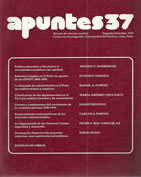Sources and components of Peruvian economic growth, 1950-1990
DOI:
https://doi.org/10.21678/apuntes.37.425Keywords:
Peru, economic growth, human capital, tax expenditure, public expenditure, liquidityAbstract
Owing to the impossibility of explaining the abrupt changes in the Peruvian economy, especially since 1968, using traditional variables (physical capital and workforce), this piece attempts to do so by applying fresh ones (human capital, government spending and real liquidity). These provide an explanation for a substantial part of the function of production in the Peruvian economy between 1960 and 1990. The use of these variables is grounded in the models of growth with endogenous technical progress, which suggest that an economy's growth does not depend on any single factor but a combination of them. The study confirms this fact for readers.
Downloads
Downloads
Published
How to Cite
Issue
Section
License
Apuntes publishes all its articles and reviews under a Creative Commons Attribution (CC BY 4.0) license with the objective of promoting academic exchange worldwide. Therefore, articles and book reviews can be distributed, edited, amended, etc., as the author sees fit. The only condition is that the name of the author(s) and Apuntes. Revista de Ciencias Sociales (as the publisher) be cited.



.jpg)
